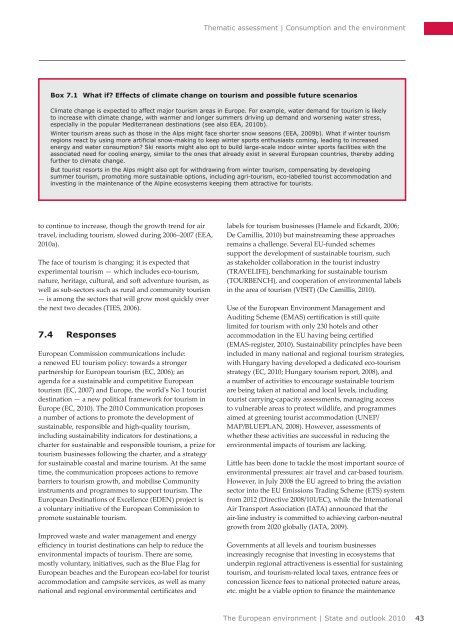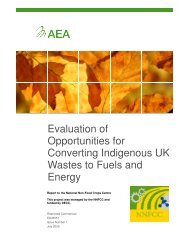Consumption and the environment (SOER2010) - European ...
Consumption and the environment (SOER2010) - European ...
Consumption and the environment (SOER2010) - European ...
Create successful ePaper yourself
Turn your PDF publications into a flip-book with our unique Google optimized e-Paper software.
Thematic assessment | <strong>Consumption</strong> <strong>and</strong> <strong>the</strong> <strong>environment</strong><br />
Box 7.1 What if? Effects of climate change on tourism <strong>and</strong> possible future scenarios<br />
Climate change is expected to affect major tourism areas in Europe. For example, water dem<strong>and</strong> for tourism is likely<br />
to increase with climate change, with warmer <strong>and</strong> longer summers driving up dem<strong>and</strong> <strong>and</strong> worsening water stress,<br />
especially in <strong>the</strong> popular Mediterranean destinations (see also EEA, 2010b).<br />
Winter tourism areas such as those in <strong>the</strong> Alps might face shorter snow seasons (EEA, 2009b). What if winter tourism<br />
regions react by using more artificial snow‐making to keep winter sports enthusiasts coming, leading to increased<br />
energy <strong>and</strong> water consumption? Ski resorts might also opt to build large‐scale indoor winter sports facilities with <strong>the</strong><br />
associated need for cooling energy, similar to <strong>the</strong> ones that already exist in several <strong>European</strong> countries, <strong>the</strong>reby adding<br />
fur<strong>the</strong>r to climate change.<br />
But tourist resorts in <strong>the</strong> Alps might also opt for withdrawing from winter tourism, compensating by developing<br />
summer tourism, promoting more sustainable options, including agri‐tourism, eco‐labelled tourist accommodation <strong>and</strong><br />
investing in <strong>the</strong> maintenance of <strong>the</strong> Alpine ecosystems keeping <strong>the</strong>m attractive for tourists.<br />
to continue to increase, though <strong>the</strong> growth trend for air<br />
travel, including tourism, slowed during 2006–2007 (EEA,<br />
2010a).<br />
The face of tourism is changing: it is expected that<br />
experimental tourism — which includes eco‐tourism,<br />
nature, heritage, cultural, <strong>and</strong> soft adventure tourism, as<br />
well as sub‐sectors such as rural <strong>and</strong> community tourism<br />
— is among <strong>the</strong> sectors that will grow most quickly over<br />
<strong>the</strong> next two decades (TIES, 2006).<br />
7.4 Responses<br />
<strong>European</strong> Commission communications include:<br />
a renewed EU tourism policy: towards a stronger<br />
partnership for <strong>European</strong> tourism (EC, 2006); an<br />
agenda for a sustainable <strong>and</strong> competitive <strong>European</strong><br />
tourism (EC, 2007) <strong>and</strong> Europe, <strong>the</strong> world's No 1 tourist<br />
destination — a new political framework for tourism in<br />
Europe (EC, 2010). The 2010 Communication proposes<br />
a number of actions to promote <strong>the</strong> development of<br />
sustainable, responsible <strong>and</strong> high‐quality tourism,<br />
including sustainability indicators for destinations, a<br />
charter for sustainable <strong>and</strong> responsible tourism, a prize for<br />
tourism businesses following <strong>the</strong> charter, <strong>and</strong> a strategy<br />
for sustainable coastal <strong>and</strong> marine tourism. At <strong>the</strong> same<br />
time, <strong>the</strong> communication proposes actions to remove<br />
barriers to tourism growth, <strong>and</strong> mobilise Community<br />
instruments <strong>and</strong> programmes to support tourism. The<br />
<strong>European</strong> Destinations of Excellence (EDEN) project is<br />
a voluntary initiative of <strong>the</strong> <strong>European</strong> Commission to<br />
promote sustainable tourism.<br />
Improved waste <strong>and</strong> water management <strong>and</strong> energy<br />
efficiency in tourist destinations can help to reduce <strong>the</strong><br />
<strong>environment</strong>al impacts of tourism. There are some,<br />
mostly voluntary, initiatives, such as <strong>the</strong> Blue Flag for<br />
<strong>European</strong> beaches <strong>and</strong> <strong>the</strong> <strong>European</strong> eco‐label for tourist<br />
accommodation <strong>and</strong> campsite services, as well as many<br />
national <strong>and</strong> regional <strong>environment</strong>al certificates <strong>and</strong><br />
labels for tourism businesses (Hamele <strong>and</strong> Eckardt, 2006;<br />
De Camillis, 2010) but mainstreaming <strong>the</strong>se approaches<br />
remains a challenge. Several EU‐funded schemes<br />
support <strong>the</strong> development of sustainable tourism, such<br />
as stakeholder collaboration in <strong>the</strong> tourist industry<br />
(TRAVELIFE), benchmarking for sustainable tourism<br />
(TOURBENCH), <strong>and</strong> cooperation of <strong>environment</strong>al labels<br />
in <strong>the</strong> area of tourism (VISIT) (De Camillis, 2010).<br />
Use of <strong>the</strong> <strong>European</strong> Environment Management <strong>and</strong><br />
Auditing Scheme (EMAS) certification is still quite<br />
limited for tourism with only 230 hotels <strong>and</strong> o<strong>the</strong>r<br />
accommodation in <strong>the</strong> EU having being certified<br />
(EMAS‐register, 2010). Sustainability principles have been<br />
included in many national <strong>and</strong> regional tourism strategies,<br />
with Hungary having developed a dedicated eco‐tourism<br />
strategy (EC, 2010; Hungary tourism report, 2008), <strong>and</strong><br />
a number of activities to encourage sustainable tourism<br />
are being taken at national <strong>and</strong> local levels, including<br />
tourist carrying‐capacity assessments, managing access<br />
to vulnerable areas to protect wildlife, <strong>and</strong> programmes<br />
aimed at greening tourist accommodation (UNEP/<br />
MAP/BLUEPLAN, 2008). However, assessments of<br />
whe<strong>the</strong>r <strong>the</strong>se activities are successful in reducing <strong>the</strong><br />
<strong>environment</strong>al impacts of tourism are lacking.<br />
Little has been done to tackle <strong>the</strong> most important source of<br />
<strong>environment</strong>al pressures: air travel <strong>and</strong> car‐based tourism.<br />
However, in July 2008 <strong>the</strong> EU agreed to bring <strong>the</strong> aviation<br />
sector into <strong>the</strong> EU Emissions Trading Scheme (ETS) system<br />
from 2012 (Directive 2008/101/EC), while <strong>the</strong> International<br />
Air Transport Association (IATA) announced that <strong>the</strong><br />
air‐line industry is committed to achieving carbon-neutral<br />
growth from 2020 globally (IATA, 2009).<br />
Governments at all levels <strong>and</strong> tourism businesses<br />
increasingly recognise that investing in ecosystems that<br />
underpin regional attractiveness is essential for sustaining<br />
tourism, <strong>and</strong> tourism‐related local taxes, entrance fees or<br />
concession licence fees to national protected nature areas,<br />
etc. might be a viable option to finance <strong>the</strong> maintenance<br />
The <strong>European</strong> <strong>environment</strong> | State <strong>and</strong> outlook 2010<br />
43








